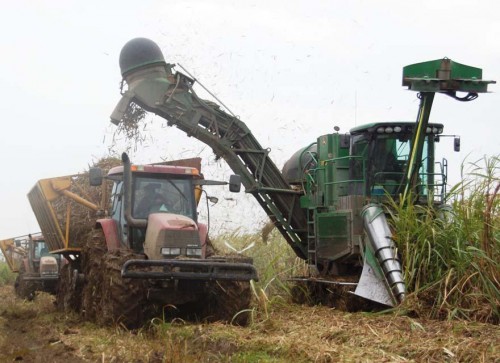Advanesser Adams
January 5, 2010Drake Touchet
January 7, 2010Winter weather woes continue to plague area sugar cane farmers, and may cost them part of this year’s crop. Record-breaking rainfalls in the Tri-parish area have made harvesting conditions difficult at best, and farmers will be harvesting their crop well into January.
“Mother Nature is truly being a redhead this year,” said Rodney Foret, a sugar-cane farmer in Raceland.
Muddy fields cause machinery to break down, drag out the harvesting process and leave extra sediment and leaves in the crop delivered to sugar mills. Worse yet, cold weather is threatening the viability of uncut cane.
“This year’s harvest is a decent crop, and thank God for that. It’s just the harvesting conditions are making it a very expensive crop to harvest,” said Jim Simon, general manager of the American Sugar Cane League in Thibodaux.
“Diesel consumption alone is 30 percent higher than normal,” said Foret. “Normal harvest for us is about two percent sediment and we’re running at almost seven right now.”
Fortunately for farmers, sugar prices are up this year, which may help them recoup some of the losses caused by the weather. Simon said better prices could push the local sugar cane industry up to $2 billion this year if farmers can get all their cane out of the fields.
“You know, everybody is talking about how the price of sugar went up. Yeah, it better go up, or we’re all going to be out of business. We can’t keep up with the costs no more,” said Foret. “If I was a betting man, I’d say there’s going to be cane lost this year. It will not make it to the factory. How much? Only time’s going to tell.”
The industry’s economic output could also be affected by lower quality in this year’s crop.
“I think the price is going to kind of help, but I think it’s going to be a down year because the quality of the sugar isn’t there. Last year, we had a light crop, but an extremely sweet crop. This year we’ve got more tons, but we don’t have as much sugar,” Foret said.
Muddy conditions will force the state’s 11 sugar mills to stay open later than usual, according to Simon. The average closing date will be about Jan. 14, and some will be open up to an additional week, said Simon. On an average year, mills try to finish up the grinding season by Christmas.
Saturated soil also causes harvesting equipment to leave knee-high ruts, which could damage next year’s crop.
“How much root damage are we doing in there with those deep ruts? It’s going to be hard to drain all that water out of there,” said Foret. “We tore up our fields. In fact, I’m looking at renting a bulldozer to fix the headlands and the field roads so we can get to the blocks.”
According to Foret, this year’s rains are second only to the 2002 harvesting season. In between, however, hurricanes have also battered the local sugar industry in recent years.
“Unfortunately, I think our industry has been numbed to the repeated beatings that Mother Nature has given out to us,” said Simon.
This year’s sugar cane efforts could also be affected by projected freezes. In spite of their own comforts, sugar farmers will be rooting for colder weather. Once cane frosts, farmers have a week or so to harvest their cane before the cane spoils, unless it gets warm, said Foret.
“It depends on the temperature. If it stays below 60 degrees, you’re all right. It won’t spoil,” Foret Said. “If it gets above that, you have a problem. It’s going to spoil.”
Given that their wallets have already taken a hit in recent years, sugar cane growers have little choice but to harvest at full speed, no matter what the conditions.
“We started in rubber boots, and we’re going to finish in rubber boots. There ain’t going to be no leather-shoe finish this year,” said Foret.
Arturo Acosta (in tractor cab at left) and Teddy Foret race to get sugar cane out of the field before a freeze or the sugar mills close. * Photo by BRETT SCHWEINBERG









